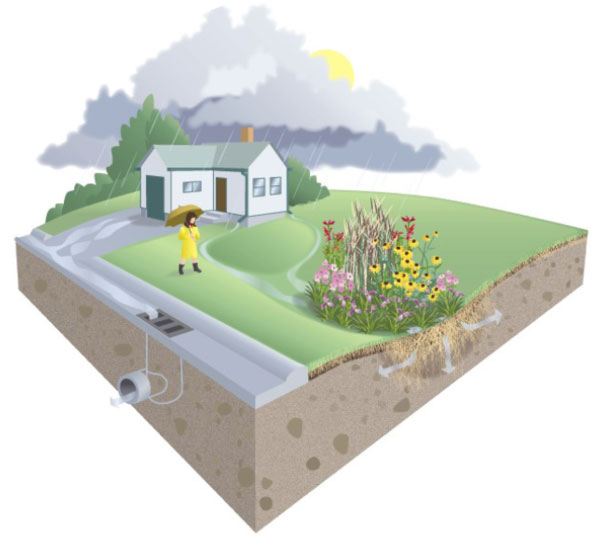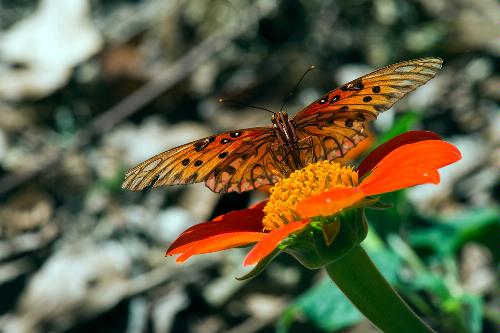A rain garden is a slightly depressed area landscaped with flowers and other moisture-tolerant plants, shrubs, and trees (usually natives) to replace areas of lawn or bare ground. Rainwater collected from the roof, driveway, or lawn conveys to this low spot and is drained naturally. The water nourishes the garden, absorbing about 30 percent more water than a conventional garden. Rain gardens are easy to maintain, and enhance the beauty of the yard.
A healthy rain garden is composed of loose, porous soil that is well mulched to create a dynamic system teeming with life. Plants absorb the water or it filters into the soil where, over time, natural chemical and biological processes break down pollutants. A well placed, carefully designed rain garden can capture runoff in all but the heaviest storms. Instead of washing your soil and fertilizers into the nearest stream or lake, rain gardens capture rainwater and allow it to filter into the soil.
Facts about rain gardens:
-
Containing the water flow helps reduce flooding and drainage problems in the city.
-
Lawn fertilizers, pesticides, oil, car fluids, and other substances are captured, utilized and broken down instead of polluting the nearby lakes and streams.
-
Slowing the flow of water helps to prevent soil erosion
-
The beauty of the yard is enhanced with a low-maintenance bed.
-
Birds, butterflies, and other wildlife are attracted to rain gardens.
See the manual Rain Gardens: A How-To Manual for Homeowners for more detailed information on the process and calculations for figuring out depth and width.
Pick the perfect spot
The garden should be placed in an area that will catch water coming from the roof and/or down spout. It should be at least 10 feet from the house so that the infiltrating water doesn't seep into the foundation. Never place a rain garden over a septic system, drain field or directly under a large tree. A full-sun area is best; however, a rain garden can be located in full to part shade.

Evaluate the soil
You can test your soil's infiltration rate by digging a small hole, filling with water and watching how fast (or slow) it soaks up. The water needs to go down at least one inch per hour. If your existing soil is already sandy, you can loosen the soil and add some compost. If you have clay soil, you will need to excavate and amend heavily with 50-percent to 60-percent sand, 20-percent to 30-percent loose topsoil and 20-percent to 30-percent compost. It is best not to place a rain garden where water already tends to stand. The idea is to encourage infiltration and if you have standing water, infiltration is already slow.
Develop a design
Basically, the garden can be any size or shape but it is suggested that the garden be 20 percent to 30 percent of the size of the area draining to the garden. You need to figure out the square footage of the area that the water will be sheeting off of (roof, lawn, driveway, etc.). For example, if the square footage of the area of roof that is sheeting towards the garden is 1,200 square feet, then the garden should be approximately 300 square feet (for more calculations see the manual referenced above). If the garden is going to be a new addition in the center of a lawn area, then have fun and choose a shape that suits you. Crescent- and kidney-shaped gardens are very effective. If the new garden will be incorporated into existing landscaping, then the existing bed lines will dictate. It is best to keep taller plants to the center or back of the garden and shorter plants to the front.
Plant selection
It is best to use native plants for a rain garden. Natives are uniquely adapted to thriving in local conditions. Once established, they will perform without much maintenance, water or fertilizer. Here is a brief list of native perennials and shrubs that work well in a rain garden.

- Blue-eyed grass (Sisyrinchium atlanticum Bicknell)
- Beautyberry (Callicarpa Americana)
- Cardinal flower (Lobelia cardinalis)
- Chipola coreopsis (Coreopsis integrifolia)
- Muhley grass (Muhlenbergia capillaris)
- Path or soft rush (Juncus spp.)
- Rainlily (Zephyranthes spp.)
- River oats (Chasmanthium latifolium)
- Swamp milkweed (Asclepias perennis)
- Swamp sunflower (Helianthus angustifolius)
- Wax myrtle (Myrica cerifera)
Prepare and plant
Most perennial gardens are "built-up" and this encourages the water to run off. However, the rain garden is "scooped-out" and encourages the water to run in. It doesn't matter what the shape is; what matters is that you have excavated enough soil to create a shallow depression with the center being deeper than the perimeter. You can use the excavated soil to create berms, if needed, or in other areas in your yard. The depth should be between 6 and 8 inches. Depth should be graduated from the edges of the garden to the center. This avoids creating a crater that can be dangerous.
After excavating the depression, you can begin planting. Rain gardens have three zones: very wet, wet to dry, and dry at the edges. If a plant is not thriving in one zone, move it to another. Sometimes the wettest areas are not where you thought they would be. Mulch in your rain garden will help keep it moist, protect plant roots and discourage weeds.
Remember that a rain garden is not merely a functioning infiltration system. Rain gardens can and should be beautiful additions to your yard. You can expect songbirds, butterflies, lots of color and even fragrances depending on what you choose to plant.
Happy rain gardening!